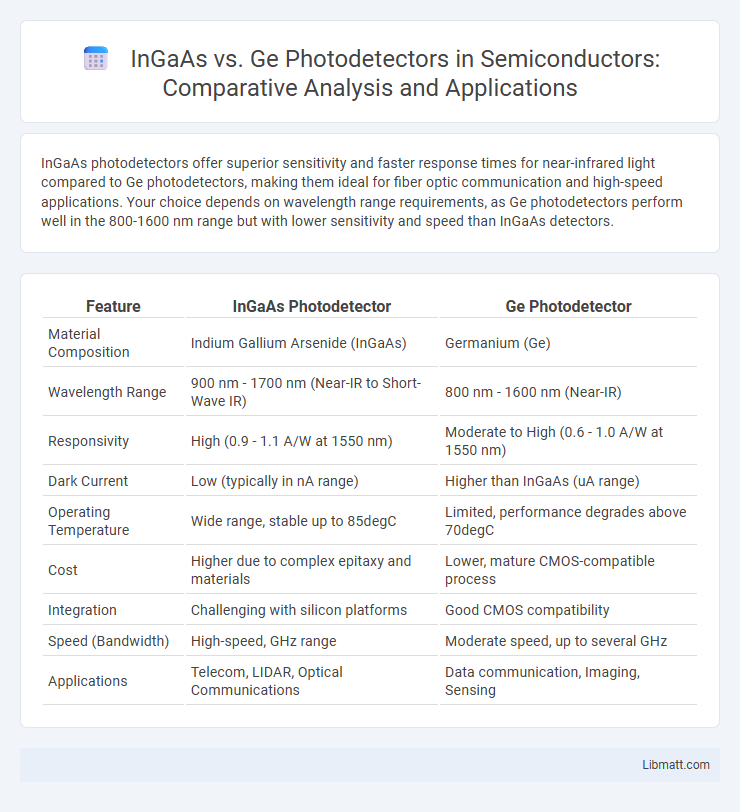InGaAs photodetectors offer superior sensitivity and faster response times for near-infrared light compared to Ge photodetectors, making them ideal for fiber optic communication and high-speed applications. Your choice depends on wavelength range requirements, as Ge photodetectors perform well in the 800-1600 nm range but with lower sensitivity and speed than InGaAs detectors.
Table of Comparison
| Feature | InGaAs Photodetector | Ge Photodetector |
|---|---|---|
| Material Composition | Indium Gallium Arsenide (InGaAs) | Germanium (Ge) |
| Wavelength Range | 900 nm - 1700 nm (Near-IR to Short-Wave IR) | 800 nm - 1600 nm (Near-IR) |
| Responsivity | High (0.9 - 1.1 A/W at 1550 nm) | Moderate to High (0.6 - 1.0 A/W at 1550 nm) |
| Dark Current | Low (typically in nA range) | Higher than InGaAs (uA range) |
| Operating Temperature | Wide range, stable up to 85degC | Limited, performance degrades above 70degC |
| Cost | Higher due to complex epitaxy and materials | Lower, mature CMOS-compatible process |
| Integration | Challenging with silicon platforms | Good CMOS compatibility |
| Speed (Bandwidth) | High-speed, GHz range | Moderate speed, up to several GHz |
| Applications | Telecom, LIDAR, Optical Communications | Data communication, Imaging, Sensing |
Introduction to Photodetectors
Photodetectors such as InGaAs and Ge are essential components in optical communication systems, converting light signals into electrical signals with high sensitivity and speed. InGaAs photodetectors offer superior performance in the near-infrared spectrum (900-1700 nm) due to their low noise and high quantum efficiency, making them ideal for fiber optic networks. Germanium photodetectors, operating effectively up to around 1600 nm, provide a cost-effective solution with integration compatibility for silicon photonics but generally exhibit higher dark current and lower sensitivity compared to InGaAs.
Overview of InGaAs Photodetectors
InGaAs photodetectors feature high sensitivity and fast response in the near-infrared spectrum, particularly between 900 nm and 1700 nm wavelengths, making them ideal for telecommunications and LIDAR applications. Their low dark current and superior noise performance provide enhanced signal detection compared to germanium photodetectors in similar spectral ranges. You can achieve improved reliability and accuracy in optical sensing using InGaAs photodetectors due to their wide dynamic range and temperature stability.
Overview of Ge Photodetectors
Ge photodetectors offer high sensitivity in the near-infrared wavelength range (800-1700 nm), making them ideal for fiber optic communication and LIDAR applications. Their compatibility with silicon-based electronics facilitates seamless integration and cost-effective manufacturing. You can rely on Ge photodetectors for fast response times and low dark current, supporting efficient optical signal detection.
Spectral Response Comparison
InGaAs photodetectors exhibit superior spectral response in the near-infrared region, typically from 900 nm to 1700 nm, making them ideal for telecom and fiber optic applications. Germanium (Ge) photodetectors cover a broader spectral range from approximately 800 nm to 1600 nm but generally show lower quantum efficiency and higher dark current compared to InGaAs in the overlapping range. The enhanced responsivity and lower noise characteristics of InGaAs photodetectors provide better performance in long-wavelength infrared detection than Ge sensors.
Sensitivity and Quantum Efficiency
InGaAs photodetectors exhibit higher sensitivity and superior quantum efficiency compared to Ge photodetectors, particularly in the 900 nm to 1700 nm wavelength range. Their bandgap properties enable more efficient photon absorption and carrier generation, resulting in increased responsivity and lower noise levels. Ge photodetectors have limited sensitivity beyond 1600 nm and generally exhibit lower quantum efficiency, making InGaAs the preferred choice for applications requiring high-performance infrared detection.
Noise Performance and Signal-to-Noise Ratio
InGaAs photodetectors exhibit superior noise performance compared to Ge photodetectors due to their lower dark current and reduced generation-recombination noise, resulting in enhanced detection sensitivity. The signal-to-noise ratio (SNR) in InGaAs devices is significantly higher, attributed to their broader spectral response and better quantum efficiency in the near-infrared range. Conversely, Ge photodetectors suffer from elevated thermal noise, limiting their SNR and making InGaAs the preferred choice for high-precision optical communication and sensing applications.
Temperature Stability and Performance
InGaAs photodetectors demonstrate superior temperature stability compared to Ge photodetectors, maintaining consistent responsivity and low dark current at elevated temperatures up to 85degC. Ge photodetectors often suffer from increased noise and reduced sensitivity when operating above room temperature, impacting performance in high-temperature environments. Your choice of photodetector for applications requiring stable performance under varying thermal conditions will likely benefit from the enhanced thermal robustness of InGaAs devices.
Cost and Manufacturing Considerations
InGaAs photodetectors generally have higher material and fabrication costs due to the complexity of III-V semiconductor processing compared to Ge photodetectors, which benefit from more mature silicon-compatible manufacturing technologies. Ge photodetectors can be integrated more easily on silicon substrates, offering cost-effective large-scale production and compatibility with CMOS processes. Choosing between InGaAs and Ge photodetectors depends on your budget constraints and the required production volume where InGaAs offers superior performance but at a higher cost.
Applications: InGaAs vs Ge Photodetectors
InGaAs photodetectors excel in fiber optic communications and short-wave infrared imaging due to their high sensitivity and fast response in the 900-1700 nm wavelength range. Ge photodetectors are commonly used in silicon photonics and optical sensing applications, optimized for detecting wavelengths up to 1600 nm with cost-effective integration. Your choice between InGaAs and Ge photodetectors depends on the required wavelength sensitivity, speed, and system integration needs.
Conclusion: Choosing the Right Photodetector
InGaAs photodetectors offer superior sensitivity and faster response times in the near-infrared spectrum, making them ideal for high-speed communication and precise sensing applications. Ge photodetectors provide a cost-effective solution with good performance in the short-wave infrared range, suitable for budget-conscious projects or systems requiring moderate detection capabilities. Your choice depends on specific wavelength requirements, speed, and budget constraints to ensure optimal photodetector performance in your application.
InGaAs vs Ge Photodetector Infographic

 libmatt.com
libmatt.com